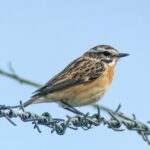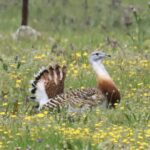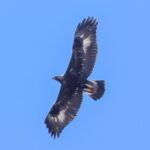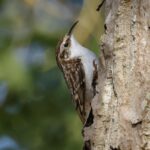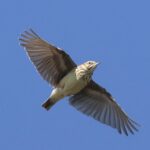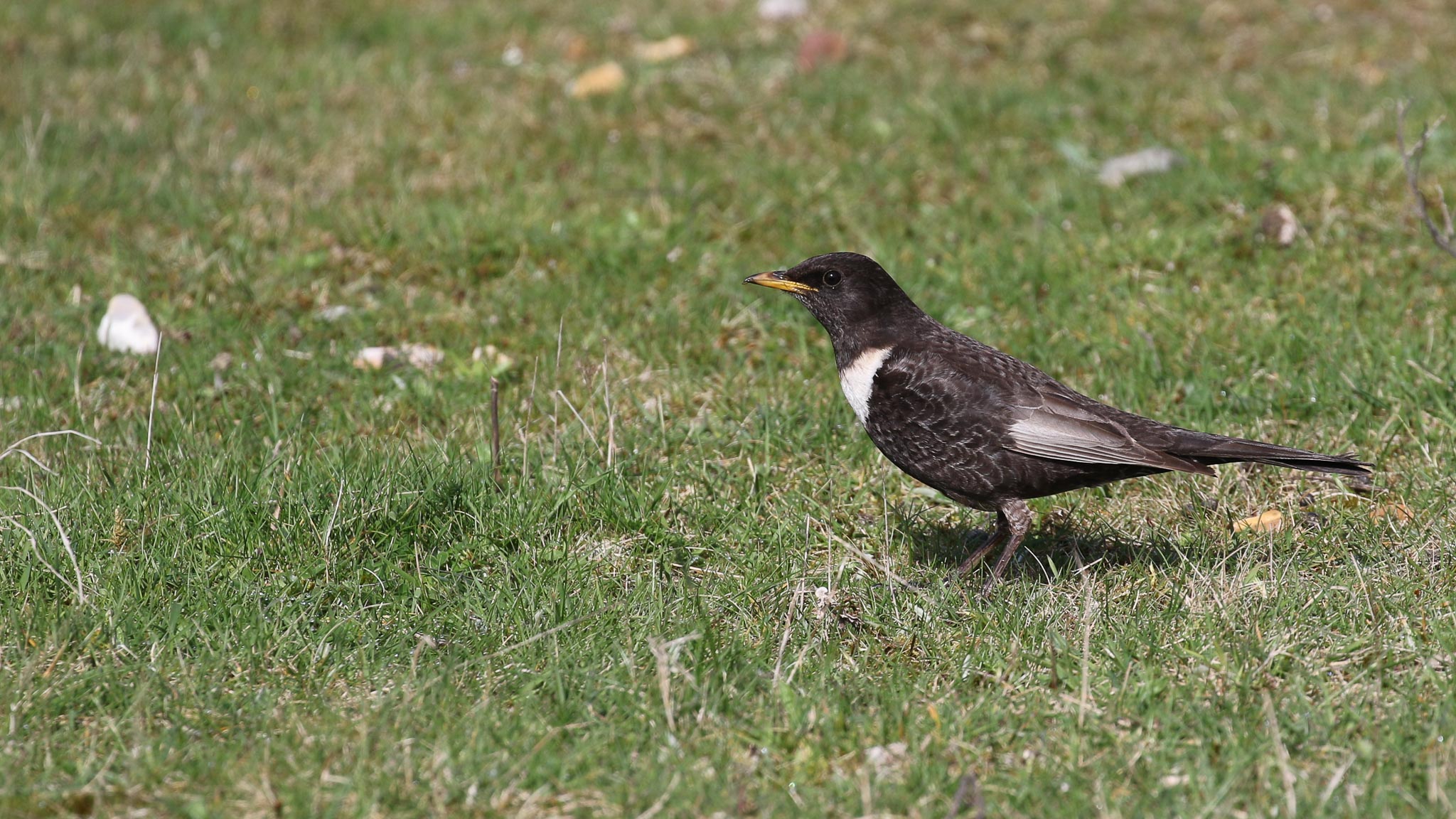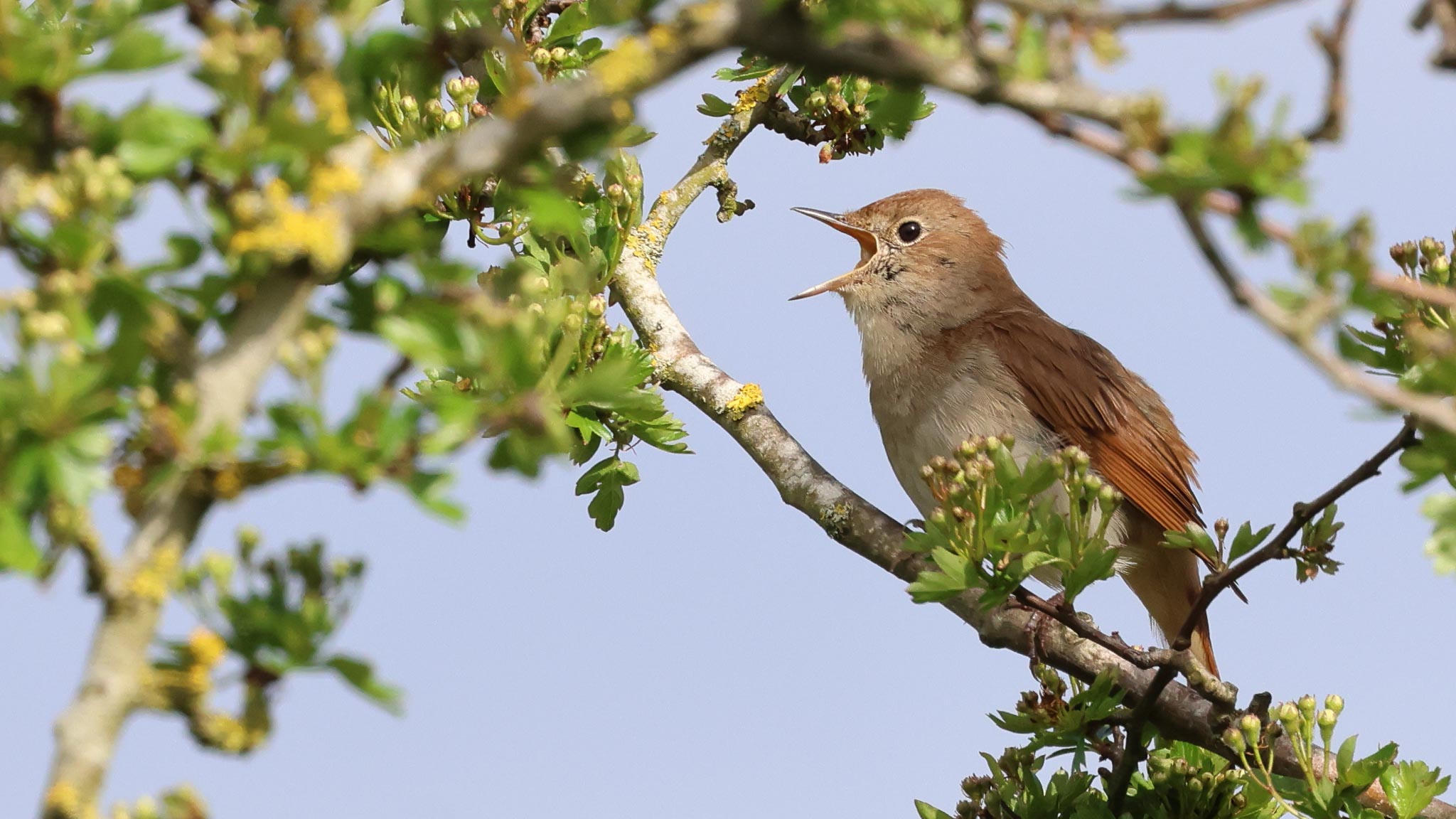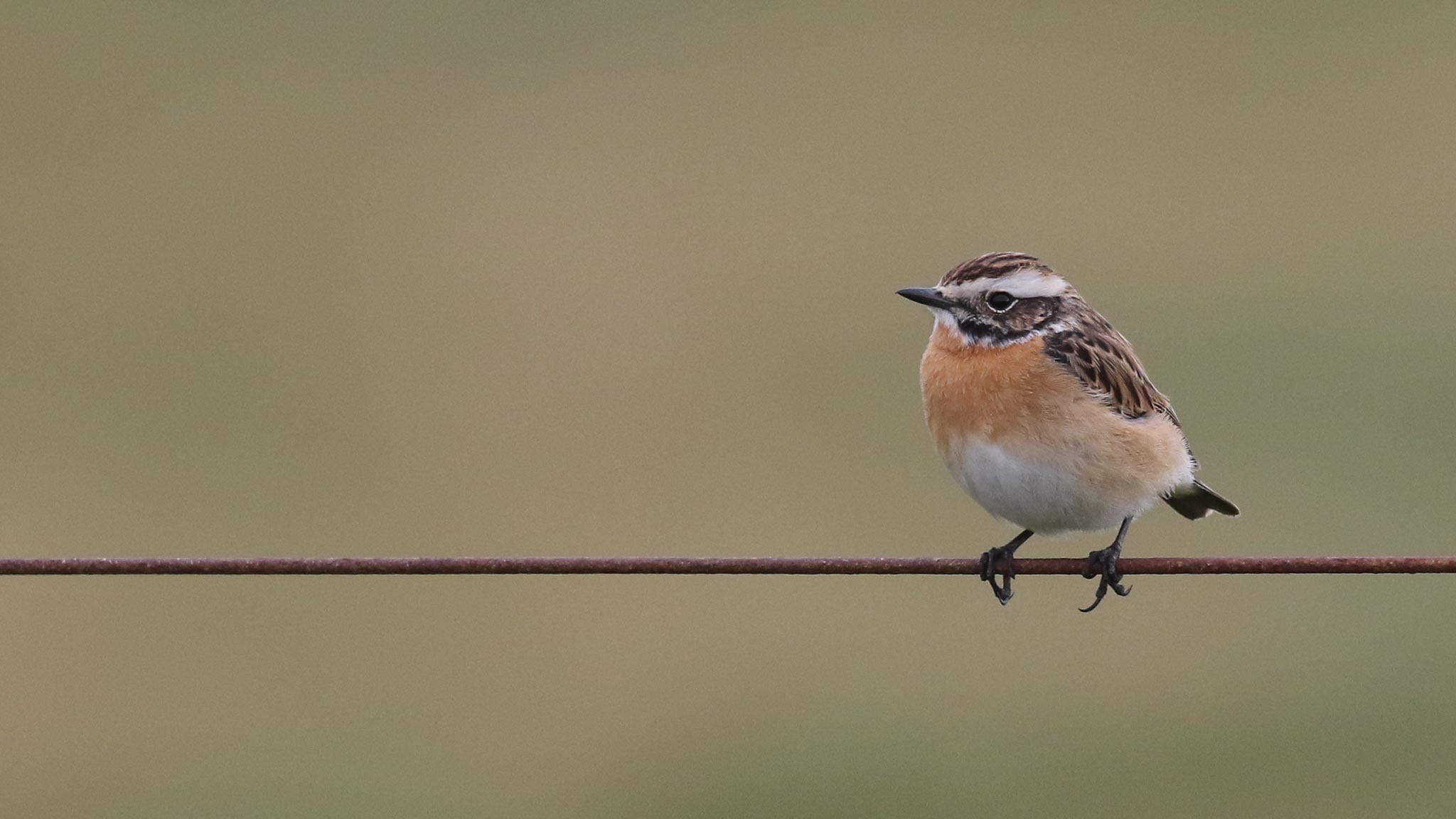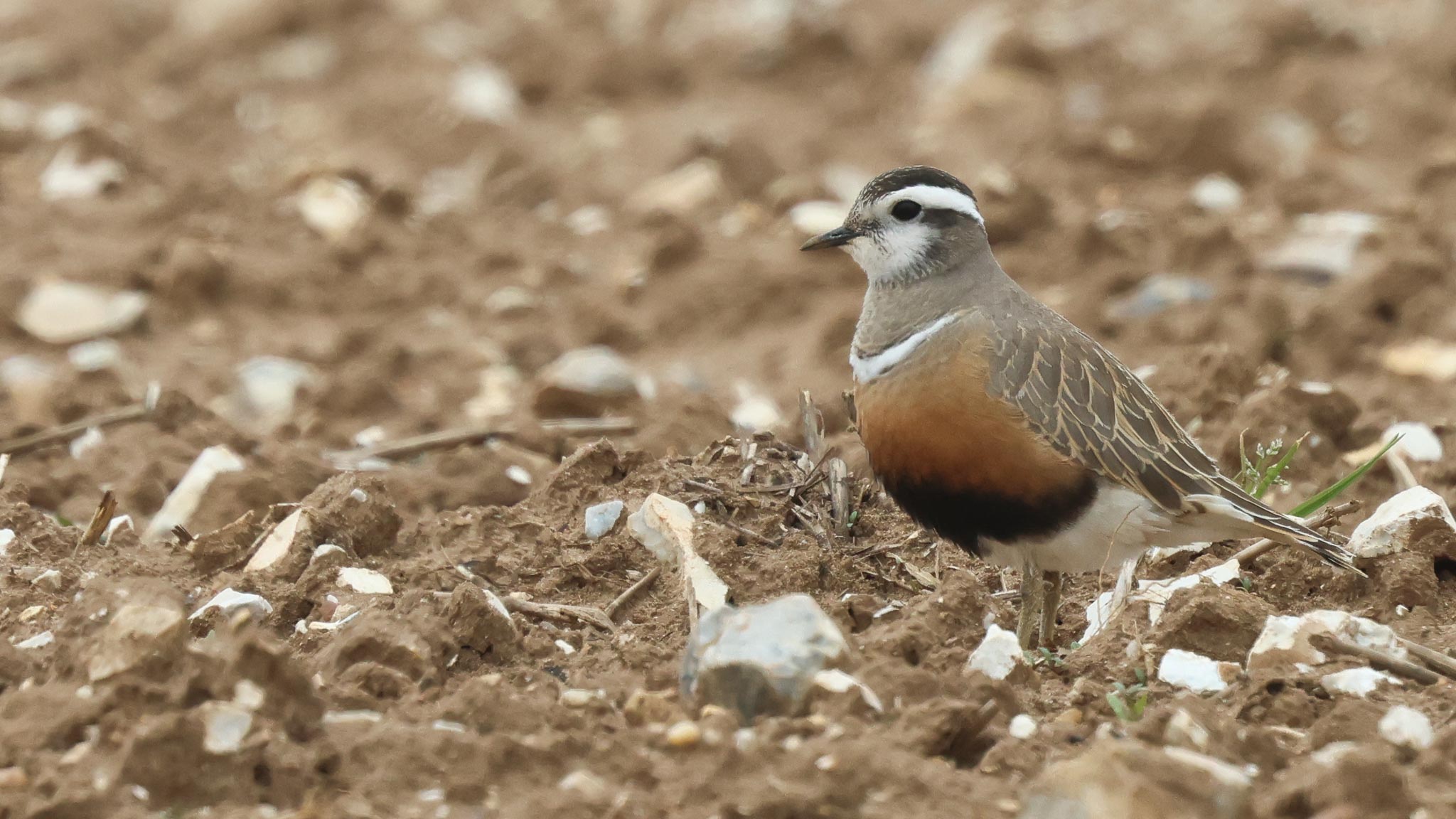A Spring 1-day Tour up on the North Norfolk coast today. It was forecast to rain, but it didn’t (no surprise there!). It was cloudy in the morning, but bright and warm, and progressively brightened up with some sunny spells in the afternoon.
Our destination for the morning was Burnham Overy Dunes. As we set off down the track across the grazing marshes, we could hear Chiffchaff and Blackcap singing in the hedge. A Goldfinch in the trees ahead of us was joined by a male Yellowhammer which flew in. There were several Shelducks out on the grass from the first gate and we could hear a Cuckoo calling off in the distance over towards the village.
Over the stile and out into the open, we scanned the grazing marshes beyond. A male Marsh Harrier was preening on the top of a bush on the edge of the reeds and another was flying round behind. Out on the grass, we picked up four Whimbrel and while we were watching them a single Bar-tailed Godwit appeared with them. We could see the rusty colouration of the godwits underparts extending right down under its tail. With the improvement in the weather and change in wind direction, birds are on the move now and we watched as they all flew off east.
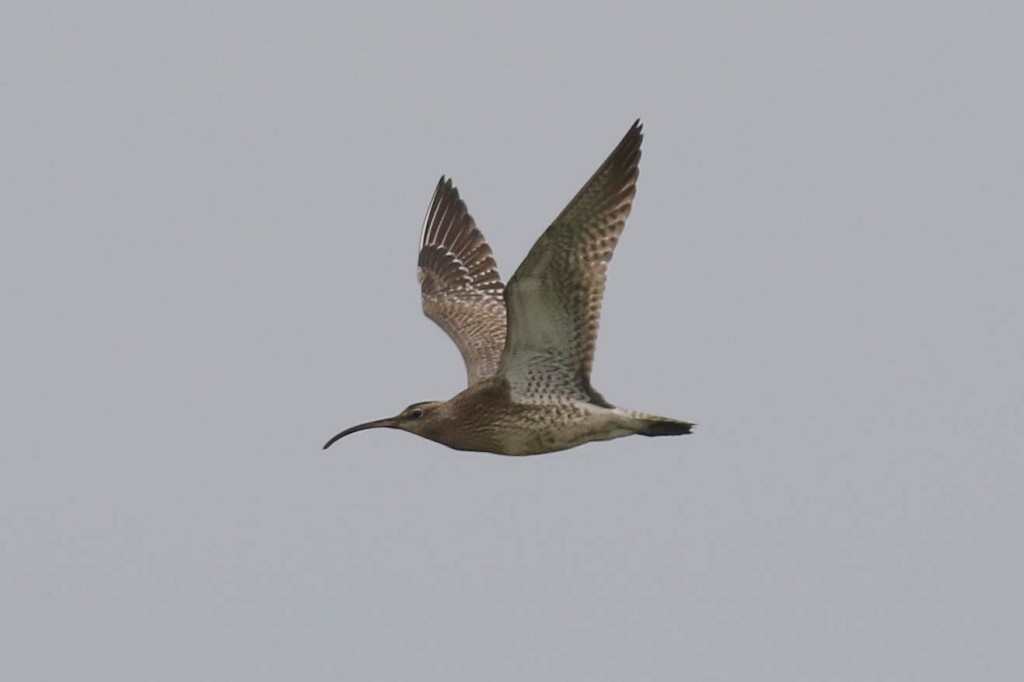
There were lots of Sedge Warblers singing all the way along the track now and we had great views of one perched up in a hawthorn, which stayed in the same place long enough for us to even get the scope on it. A Cetti’s Warbler shouted from the bushes.
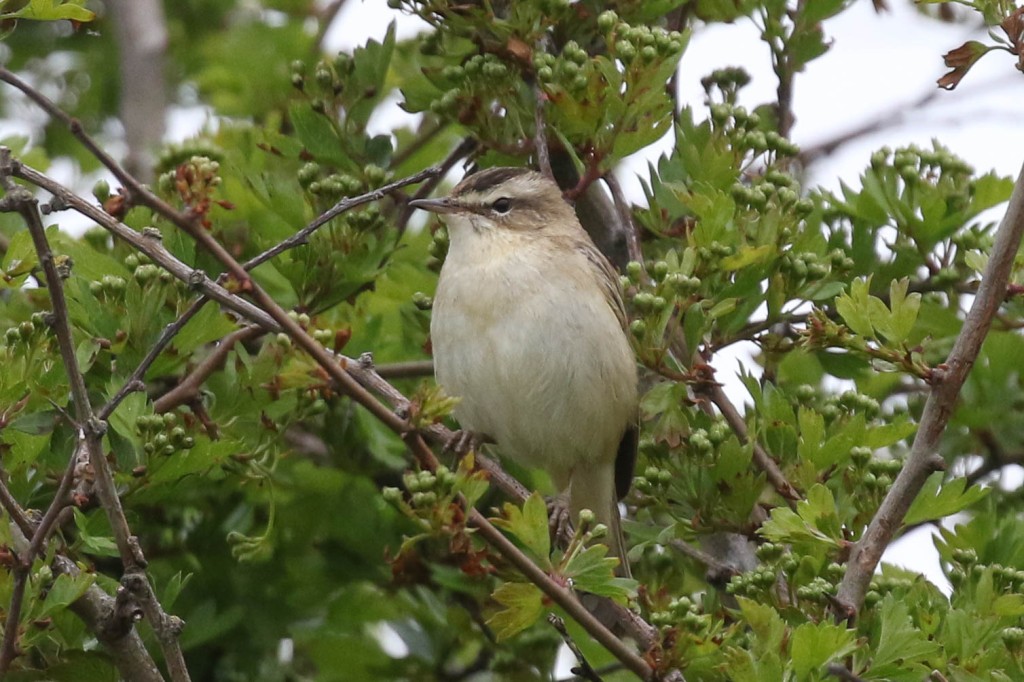
The smaller pools on the grazing marsh are drying up fast now, but the larger pools still have quite a bit of water. We could see several Lapwings, Redshanks, Avocets and Oystercatchers here. We put the scope on a smart male Lapwing. A pair of Egyptian Geese were picking around on the mud, a Canada Goose was an addition to the list down in the grass at the back, and there were a few Teal, Shoveler and Coot too.
Talking to one of the wardens who was on his way back from an off-duty visit to the dunes, a Spoonbill flew over and disappeared off towards the colony. We could hear Mediterranean Gulls calling high overhead on the way out and one flew past now at eye level, a smart adult with jet black hood and clean white wing tips.
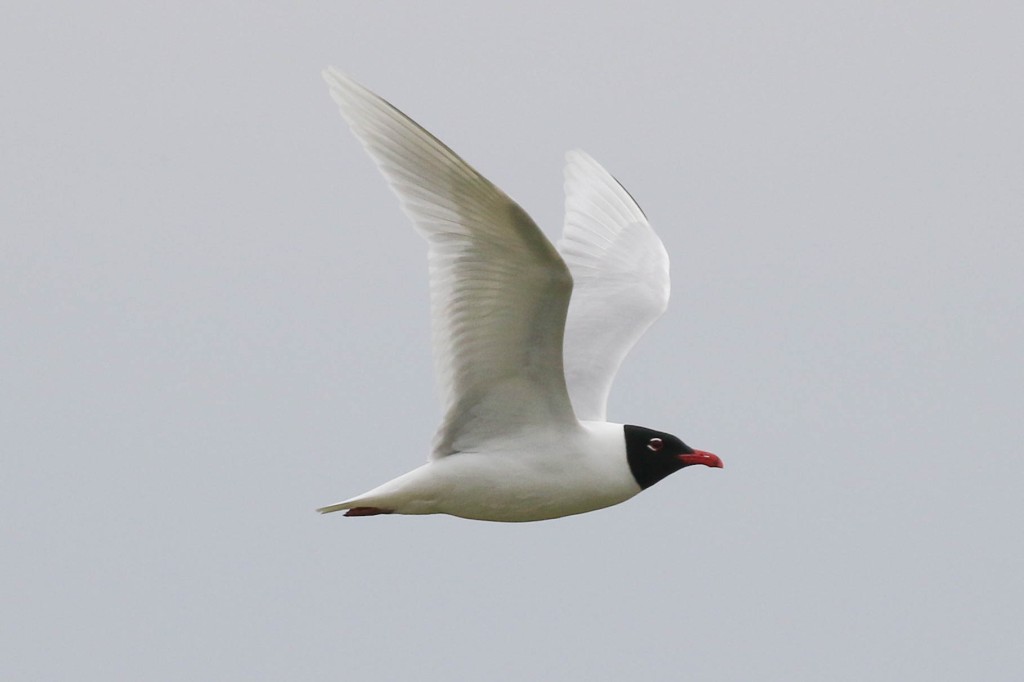
By the far gate, below the seawall, our first Reed Warbler of the day was singing in the reeds. It’s more rhythmic song was noticeably different from the Sedge Warbler singing nearby (which seemed to have included an impression of a squeaky toy into its varied repertoire!). We could actually see the Reed Warbler perched up in the reeds, noticeably plainer than the Sedge Warblers.
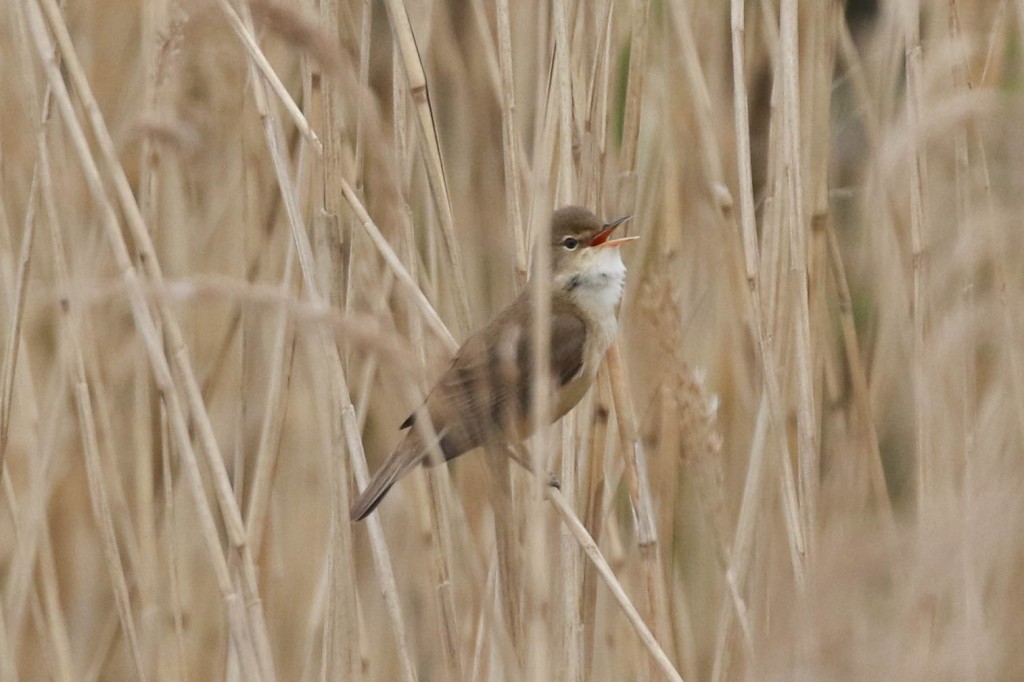
Up onto the seawall, the tide was out now. There were a couple of Grey Plover on the mud below, one getting into its smart breeding plumage, and several Black-tailed Godwits, plus lots more Avocets and Redshank. Further up, we could see lots of lingering Brent Geese out on the saltmarsh.
A Bittern boomed from the reeds behind us. We turned to scan the reedbed pool, which held a lone Great Crested Grebe. A Great White Egret flew past, showing off its long legs and black feet, and another Great White Egret was distantly out on the grazing marsh beyond. Several Common Pochard were swimming round in a small pool in the reeds further up.
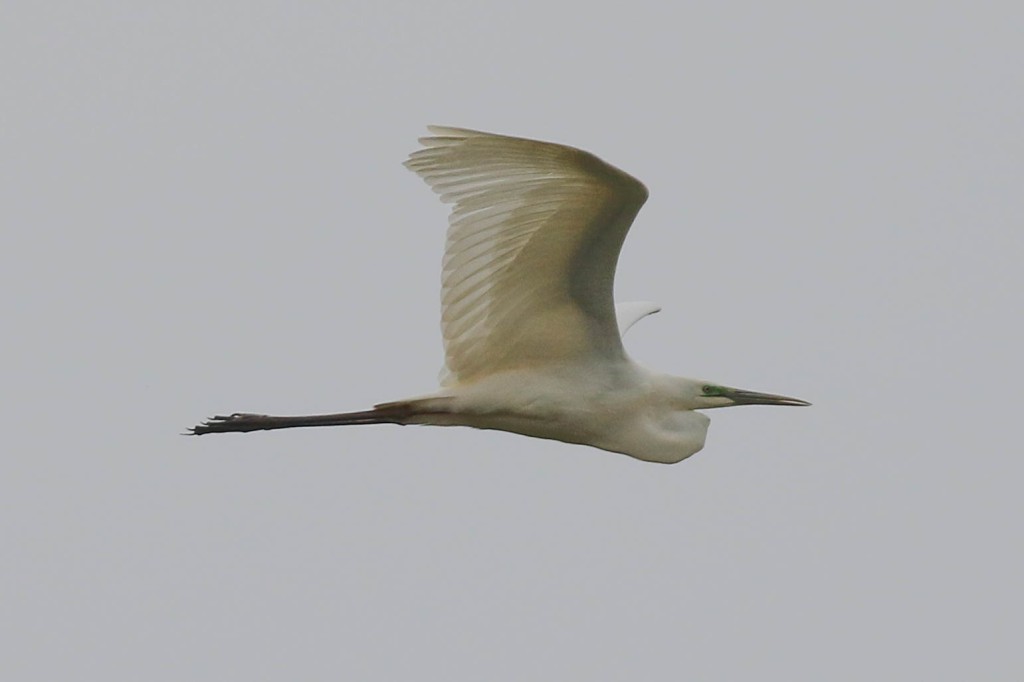
There had apparently been lots of Yellow Wagtails on the move along the coast this morning, so we stopped to look at the cows out on the grazing marsh beyond the reedbed. Most of the cows were lying down, but we could see at least one bright Yellow Wagtail around the feet of one which was standing. They were hard to see here though, as the cows were in the longer grass on the edge of the reeds..
Further out, we stopped to scan the harbour from the seawall. Two Little Terns were out fishing over the water in the distance, and one landed on one of the shingle spits. Our first Little Terns of the year, just returned for the breeding season.
Continuing on to the dunes, we bumped into one of the locals who told us he had just seen two Ring Ouzels to the west, so we walked out towards Gun Hill. We couldn’t find any sign of the Ring Ouzels now, although they can be very mobile out here. There were a few hirundines trickling through all morning, migrating west, mostly Swallows, but we saw a couple of House Martins and one Sand Martin with them.
A male Wheatear was perched on the rope fence down by the houseboats, but there was no further sign of the Little Terns in the harbour now. As we cut back round through the middle of the dunes, we came across a pair of Stonechats, the first of several, a big flock of Linnets and a few Meadow Pipits
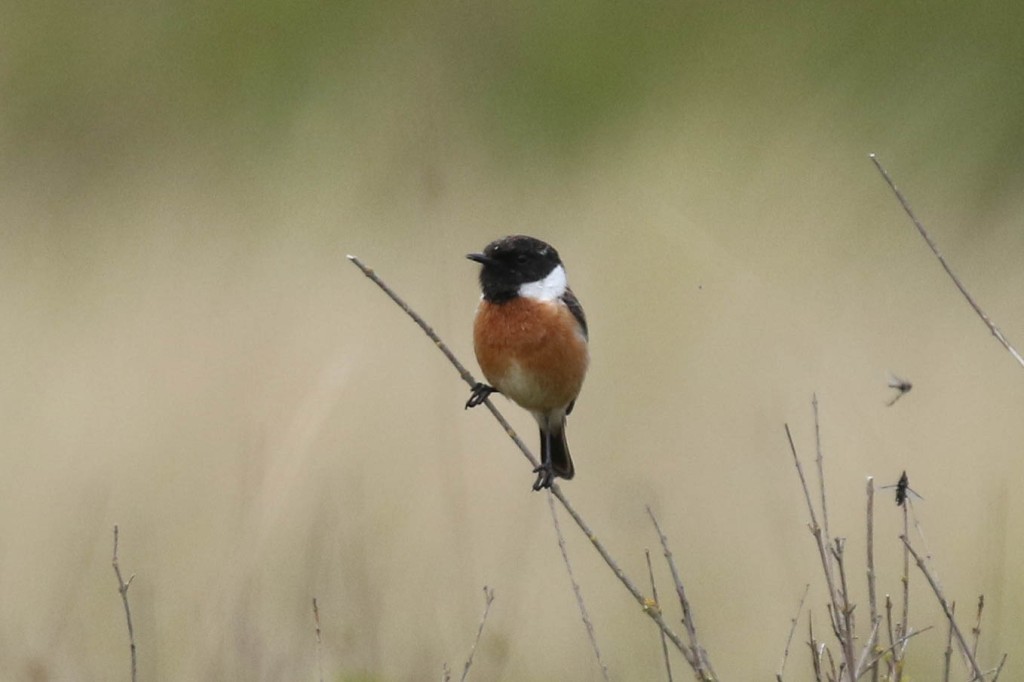
We had a message now to say the Ring Ouzels had just been flushed by dogwalkers in the dunes further east, so we made our way back past the boardwalk. Another Wheatear flushed ahead of us flashing its white rump and tail base.
As we came over a crest in the dunes, we could see a female Ring Ouzel distantly in the top of a bush beyond the fence. We had a good view of it through the scope, its pale crescent noticeably off white. It seemed to be catching insects in the top of the bush, hopping round through the branches. A brighter male Ring Ouzel appeared briefly in another bush beyond, so we decided to walk down for a closer look.
Two Red Kites chased each other over the dunes and hung in the air, one a very tatty young bird, moulting its wings. A Kestrel was circling low nearby and scanning the sky we picked up a more distant Hobby hawking for insects over the grazing marshes by the west end of the pines. A male Marsh Harrier was displaying miles up into the sky, little more than a dot unless viewed through the scope.
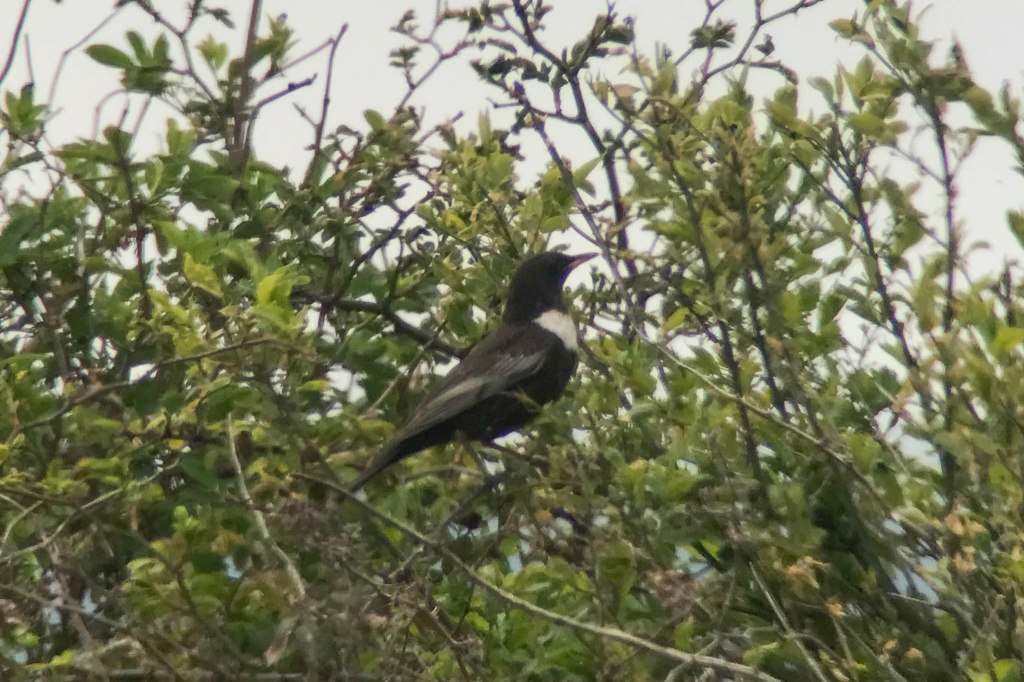
The male Ring Ouzel flew in and landed in a bush in front of us now, and we had a good look at it through the scopes, blacker than the female with a whiter crescent on its breast. The female dropped in with it, then they both flew off over the dunes.
There was no news of anything else interesting turning up further down towards the pines, so we turned round to head back. As we walked back through the dunes, there were two Wheatears now which flicked along the line of fence posts ahead of us and then out into the dunes – a smart male with black face mask and a browner female without.
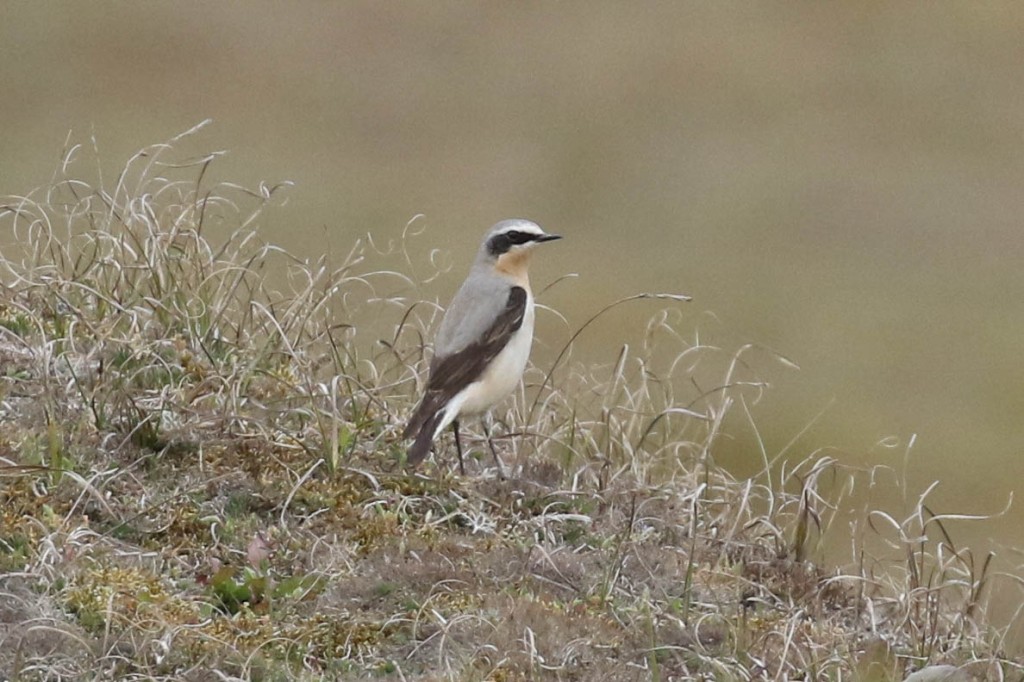
There were a few butterflies out in the dunes too, now that it was a bit warmer. In particular, we saw several Wall, our first of the year today.
Back along the seawall, there were more cows and calves now, and even better they were standing up and feeding. There were more Yellow Wagtails too, and the more we looked the more we counted. By the end, we had seen at least 15 at the same time and there could have been more. There were some very smart bright yellow males, and we watched as they fed in and out of the cows feet and round their noses. Amazing they don’t get trodden on!
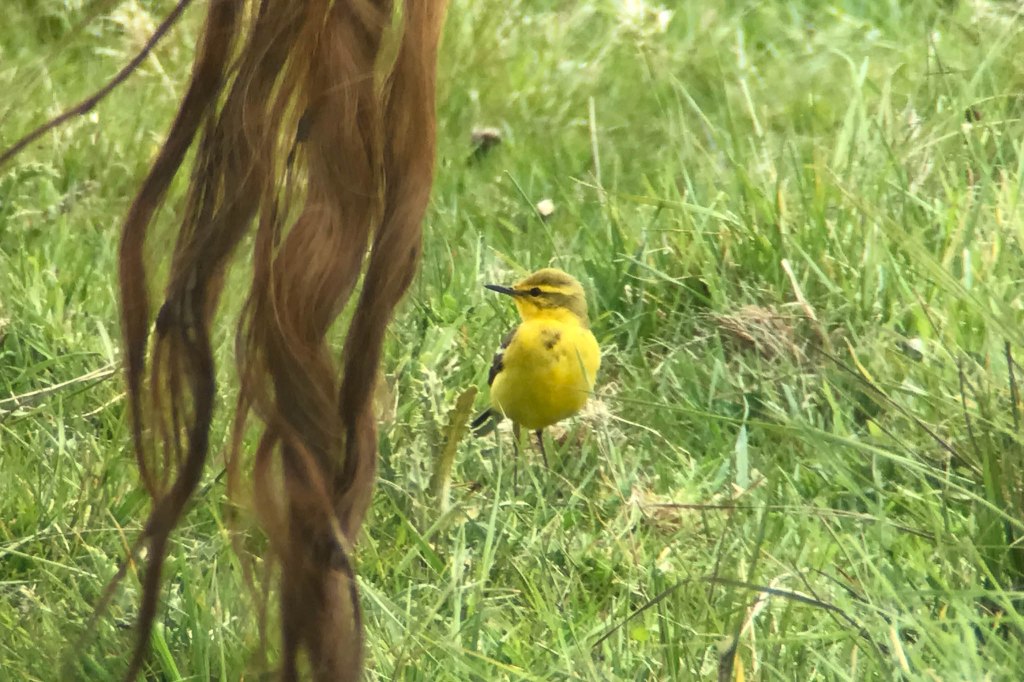
Back along the track over the grazing marshes, another Spoonbill flew over, heading off west this time. Then it was time for lunch, and we drove round to Holkham to The Lookout. It was nice there, sitting out in the sunshine on the picnic tables, even if a bit too busy. Over lunch, we counted at least twelve Pink-footed Geese still on the grazing marsh by Lady Anne’s Drive. Several Whimbrel flew back and forth and a few raptors of various shapes and sizes drifted over. A Mistle Thrush was out on the grass at the back.
After lunch, we headed on through Stiffkey. There were several Roe Deer feeding in the field next to where we parked. As we made our way down through the copse, we could hear Blackcaps singing. Down by the river, there were a couple of people looking for the Dusky Warbler, but there had been no sign all day. It was the middle of the day now though, and perhaps a bit busy along the path. We did have nice views of a Chiffchaff above us and we heard a Lesser Whitethroat singing along the path ahead of us.
The tide was out now in the harbour. We could see a large mob of Sandwich Terns distantly out on Blakeney Point which flushed and swirled round in the sunshine. A single Whimbrel was feeding in the harbour channel.
Turning our attention to the Fen, there were quite a few Black-tailed Godwits and two Ruff. A single Little Ringed Plover was hiding behind the reeds and not easy to see. A White Wagtail was feeding around the edges of the islands with several Pied Wagtails. There were a few ducks, most notably a lingering drake Wigeon out on the water.
A Spoonbill flew in over the seawall and dropped down onto the Fen. It started feeding briefly, walking around and sweeping its bill side to side through the shallow water. Then it decided to have a bath, splashing and whipping up showers of water, its bushy nuchal crest flapping around as it did so. We could see the yellow tip to its bill too, and the mustard wash on its breast, an adult in breeding condition.
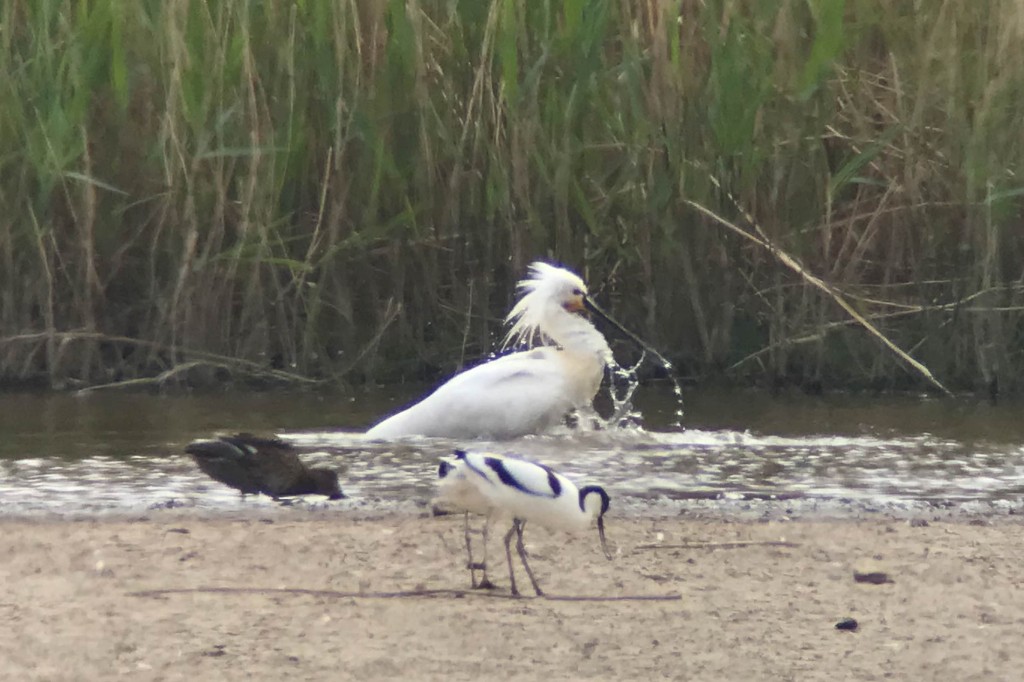
A male Marsh Harrier was feeding on something in the reeds at the back. It was flushed by a female, but didn’t want to give up its prey, landing back down on the ground. It was then the turn of a Grey Heron to see if it could get a free lunch, but the harrier took off and took its lunch with it.
We had a slow walk back along the permissive path, but there was still no sound of the Dusky Warbler. So we decided to move on and made our way back to Wells. There were a couple of Grey Partridges in the field opposite where we parked. It was definitely a day for Yellow Wagtails, and we could hear more calling now. We looked across the other side to see another four with the cows out on the grazing marsh.
Scanning the pools, there were lots of Common Snipe, but we couldn’t find the Jack Snipe today – it was presumably hiding somewhere in the dense rushes. One Lapwing had a couple of small chicks. As we walked down the track, a Spoonbill appeared on the far edge feeding. A few Swallows came over, birds still on the move this afternoon. A Marsh Harrier was displaying overhead and another circled low above us.
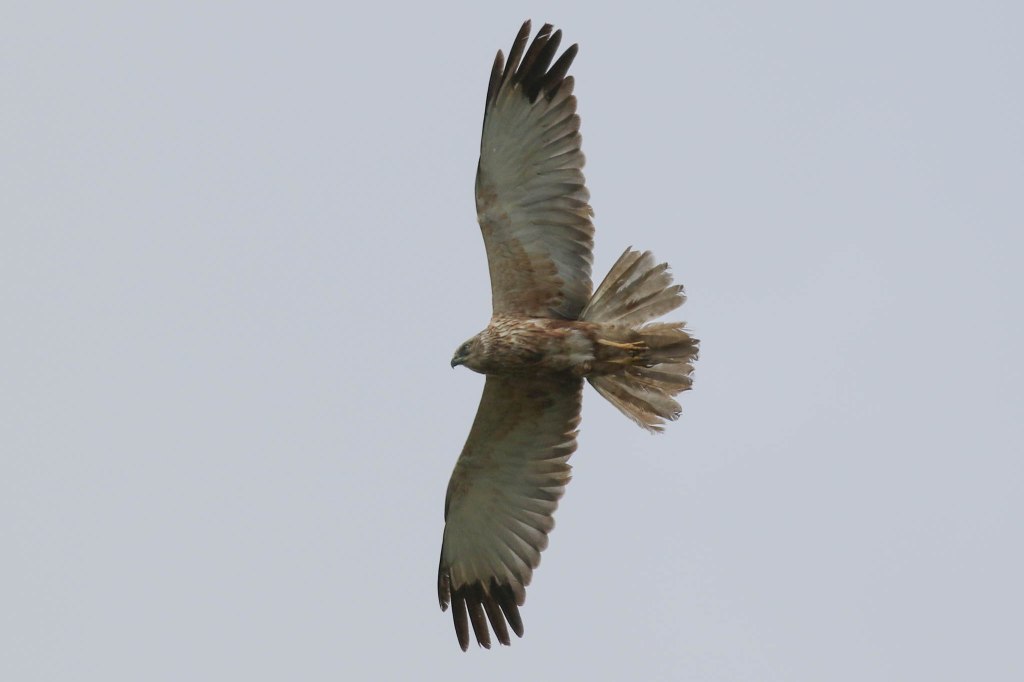
A Little Ringed Plover was out on the mud – much better views here compared to the one at Stiffkey, we could even see its golden-yellow eye ring. It was lovely here in the afternoon sunshine, we could have stayed for hours, but unfortunately we had to be heading back. Home time.
